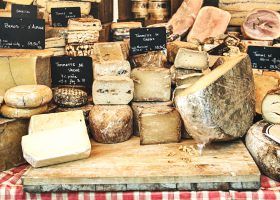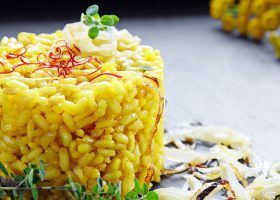Let’s face it, Italian cuisine is one of the most delicious on the planet. However, many travelers are surprised that the food in Italy is not the same as what they eat back home. No Chicken Parmesan! When you’re not sure what to order, try these authentic dishes and drinks in Italy.
Pro Tip: Planning can be tough, but it’s easier to organize your trip when you have all your resources in one place. Bookmark this post along with our top food and wine tours in Italy. No matter where in Italy you end up, join a local food tour for good traditional food and a fun evening out exploring!
17 Authentic Dishes and Drinks To Try in Italy
Italian cuisine is a favorite around the world. However, the vastness of this food culture means we can’t cover everything, especially when you start adding in regional dishes, desserts, and drinks. Nobody knows the local food better than a local, which is why we always recommend going on food tours when you visit a new city.
It’s the perfect thing to do on your first night because you’re gauranteed authentic food in well-loved local establishments. You’ll try new foods, get to know the city on a short walking tour, and have a fun evening. Is there a better way to start your vacation?
Your guide will also give you some restaurant recommendations for the rest of your trip, so there’ll be no tourist traps or disappointing meals for you. In this guide, we’ll help you navigate restaurant menus in Italy and guide you to the top foods and drinks to try.
This way, you’ll leave having experienced a real taste of Italy! Before we dive into what to try in Italy, here’s a quick introduction to the Italian terms for the different courses you’ll encounter.
Italian terms for different meal courses:
- Aperitivo: This is the classic before-dinner drink and is always accompanied by some kind of snack
- Antipasto: The appetizer before the main courses
- Primo: The first of the main courses, usually soup or pasta
- Secondo: The second of the main courses, usually meat or fish
- Dolce: Dessert
- Digestivo: After dinner drink—something to aid digestion
Not ready to book a tour? Find out if a Rome food tour is worth it.
17. Spritz
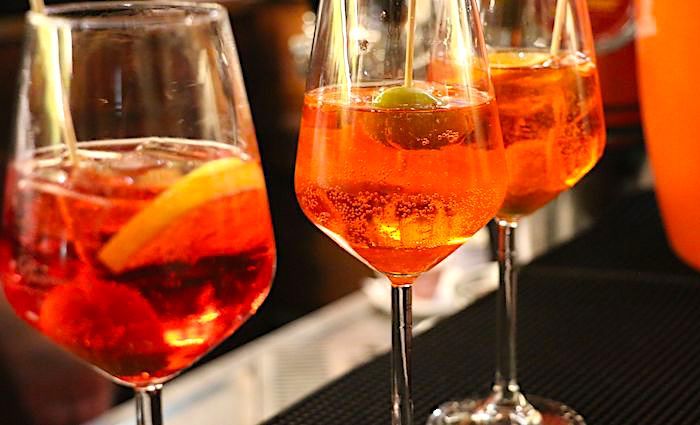
Aperol or Campari Mixed Drink | Aperitivo | All of Italy, Especially in Venice
Today, you can order a spritz anywhere in Italy. However, this light aperitivo originates in the Veneto region. In the 1800s, during the Hapsburg reign over the Veneto region, the Austrian soldiers were neither used to the wide selection or the strength of the wine as in Italy.
So, they would ask the bartenders to spray (spritzen in German) some water into the wine to weaken it a bit. They added some sparkling water to a glass of white or red wine.
In the 50’s, it became quite popular to add either Aperol (an orange, sweet mixture) or Campari (dark red and bitter) into the mix instead of the classic wine mixed with soda. That’s why, when you go into a bar and ask for a spritz in Venice today, they’ll ask if you want Campari or Aperol. If you’re spending time in the Floating City, check out other top food and drinks to try in Venice.
16. Risotto
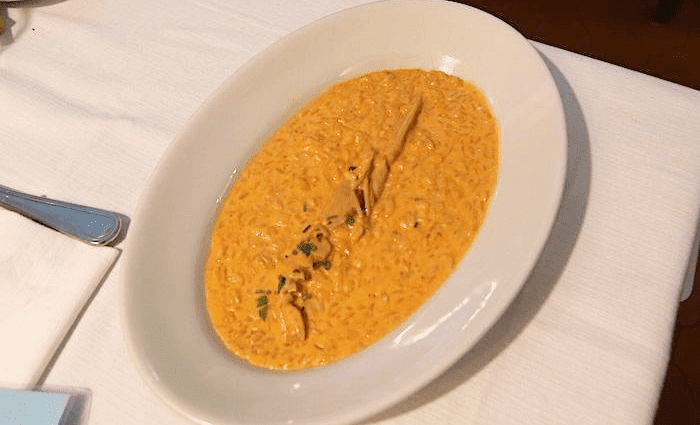
Rice Dish | Primo | All of Italy
Risotto is a rice dish and a favorite throughout the country. It might not seem anything special, but there are countless variations of this beloved dish throughout Italy. The key to a good risotto are the other ingredients you add.
For example, in the photo above, you have risotto with scampi cream. There’s also the famous risotto alla Milanese with saffron—the top food to try in Milan! It’s possible to add just about anything as long as you start with a good base.
The base begins with the broth. Any true risotto will have a broth made from scratch. The type of broth you use will depend on the ingredients, so you’d use a vegetable broth with vegetables and a meat broth with meat.
In Italy, the risotto dish begins with toasting the rice a bit in a pan and then adding some wine. Once the alcohol has evaporated, you start with the broth. At this point, you throw in everything you want to eat and keep adding broth when it has evaporated. Once you’ve had a true risotto, you never go back!
15. Tiramisu
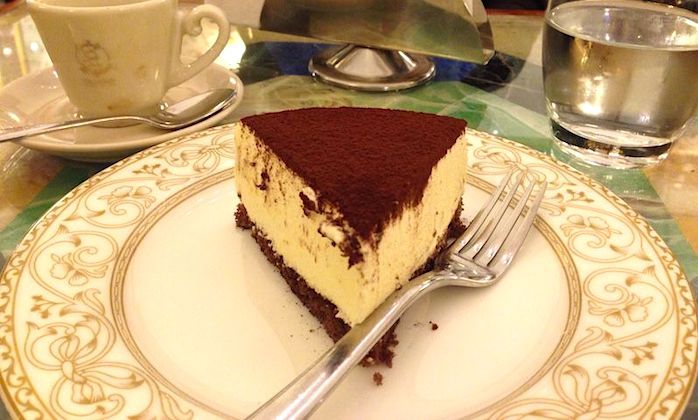
Coffee and Mascarpone | Dolce | All of Italy
The literal translation of tiramisu is “pick me up,” so-called for its coffee content. It’s a very popular dessert among both Italians and visitors. There are already many spin-offs, like strawberry tiramisu or other flavors. However, I prefer the classic taste.
When made correctly, the cream will be light and fluffy and pratically melt in your mouth. The contrast of the bitter coffee and cacao are offset by the sugar in the cream and cheese. This is a taste sensation you don’t want to miss in Italy!
14. Filetti di Baccalà
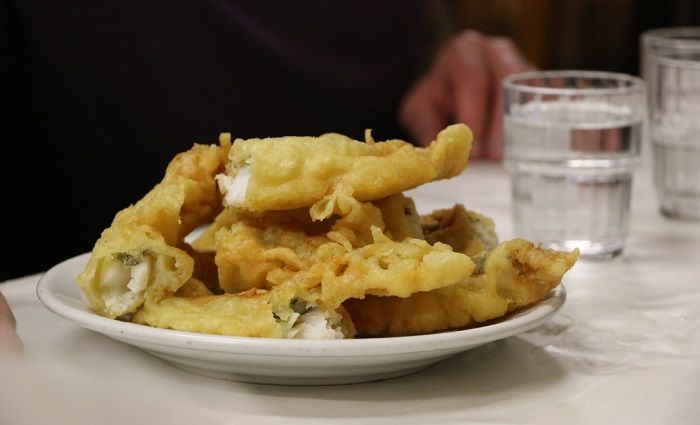
Fried Codfish | Antipasto | Mostly Rome or the South
Filetti di Baccalà is basically the Italian version of fish and chips. It differs from the English version as it is a bit less greasy, the batter is a little lighter, and the portions are a little smaller.
You also won’t be served chips but normally some other vegetable. Italians generally eat filetti di bacalà as an appetizer with pizza and quite often before or after watching a football match. If you want to try authentic baccala in Rome, reserve your spot on our Trastevere food tour!
13. Limoncello

Lemon Liqueur | Digestivo | Amalfi Coast
It would be impossible not to mention the king of drinks—Limoncello! While this lemon liqueur is exported, it’s very popular in the Bel Paese as well. You can find this drink all around the country, but the best place to enjoy it is on the Amalfi Coast. It always tastes better where it’s made!
To make limoncello you need lemons and the best lemons come from Sorrento and the Amalfi Coast. All you need to make limoncello are lemons, sugar, alcohol, and water.
Once, at a limoncello farm, I tried to get the nonna (grandma) to tell me her secret recipe and she gave me the death look. So, I knew to quit while I was ahead. From what I know, you take the lemon peels and soak them in pure alcohol for a period of time. Then, at some point add sugar and water. What I do know is that it’s delicious after a meal!
12. Pasta Carbonara
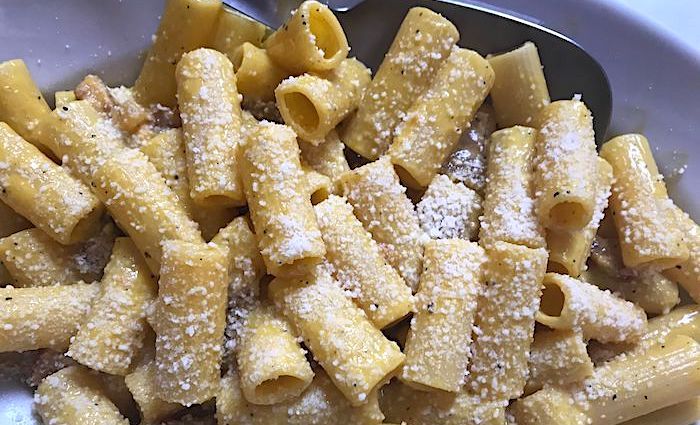
Pasta with Egg and Pork | Primo | Mainly Rome
It goes without saying that when you’re in Italy, there are certain pasta dishes that need to be on your bucket list. This dish is insanely simple to make, but it takes quite a bit of time to master. It only takes four ingredients to make what is arguably one of the best pasta dishes on the planet.
They are Guanciale (similar to Pancetta, but not quite), egg yolks, Pecorino Romano cheese, and crushed black pepper. That’s it! When you’re in Rome, order pasta Carbonara. That’s where it comes from and that, in my opinion, is where it will taste the best.
11. Supplí
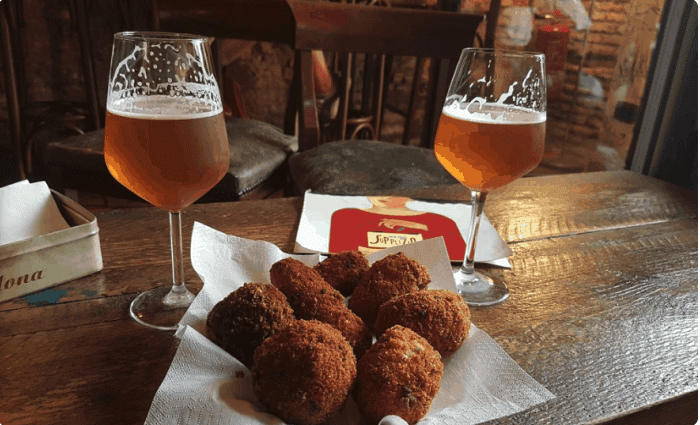
Fried Rice Balls | Antipasto | Mainly Rome
These showed up on the map, at least in writing, around 1847 at a restaurant in Rome named Trattoria Della Lepre. The restaurant is no longer active, but I couldn’t imagine this dish was at fault.
Basically, supplí are rice mixed with a light meat sauce and pecorino cheese with a small ball of mozzarella cheese at the center. It’s fried in an egg and bread-based shell, which is crunchy and delicious!
You’ll see these on the menu of most authentic pizza places and definitely at any takeaway pizza place where you can get pizza al taglio. You’ll definitely do a lot of walking in Rome and these little treats will come in handy when it’s 4 pm and you’re starving but restaurants don’t open until 8 pm. Pop in, grab one for a couple euros, and eat it on the go.
10. Bistecca Fiorentina
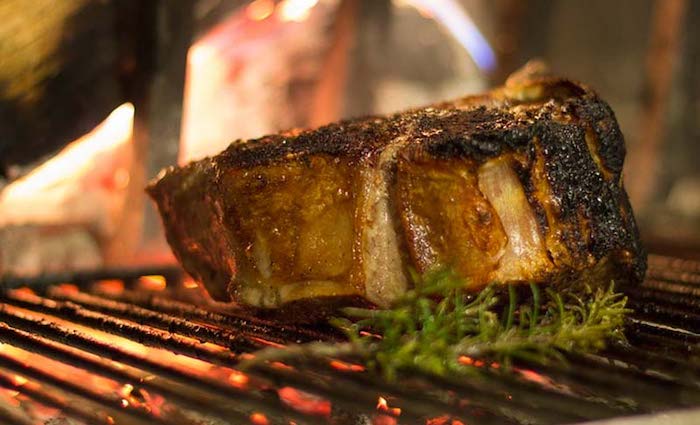
Steak | Secondo | Florence
The bistecca Fiorentina is what it sounds like—a Florentine steak. The cut of meat is generally veal or from a heifer but must be from the Chianina breed of cattle that has origins in Siena. Before ordering this steak you should know it is commonly served rare.
Like most Italian recipes, there’s no fancy marinade. The flavor comes from the high-quality cut of meat and salt, which brings that flavor forward. However, salt or pepper cannot be added until after it is cooked.
What makes this steak “Fiorentina” is grilling it over hot coals. The steak is bone-in and similar to the American T-bone. It doesn’t take many ingredients to make this steak, but if you want to try the best go to those who know! When you’re in Florence, join our Florence Food Tour and enjoy a traditional bistecca Fiorentina sit-down meal.
Not ready to book a tour? See our best Florence tours to take and why.
9. Cicchetti
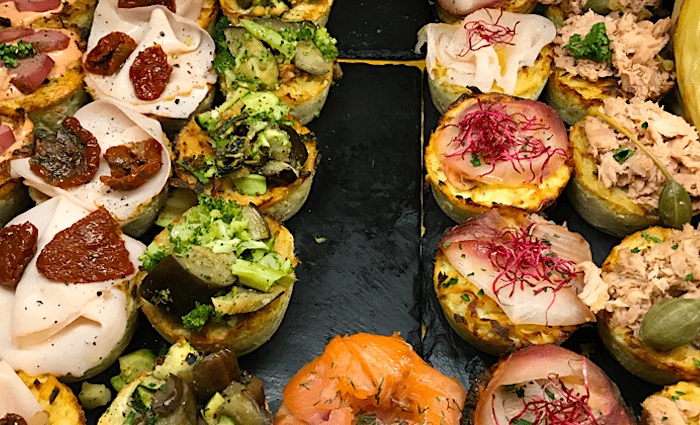
Snack Sized | Antipasto | Venice
Cicchetti are typical Venetian small plates or finger foods accompanied by a glass of wine or Spritz. Don’t miss out on this food tradition when you’re in Venice! Lots of place serve these bite-size dishes, but you’ll want the inside scoop on where to get the best most authentic ones.
The simplest way is to join a local guide on our Venice food tour. Not only will you eat the best cicchetti in town, you’ll also sample other typical Venetian foods and drinks and see a bit of Venice as you go from one food stop to the next.
It might surprise you, but eating and drinking in Venice on a budget is actually quite easy and cicchetti is the secret. These bites of Venetian tradition are both cheap and filling, ranging from about €1 to €3 per plate. As always, ask the staff what you should eat and drink and trust them. Menus are for tourists. Check out where to get the best cicchetti in Venice.
8. Mozzarella di Bufala

Buffalo Cheese | Antipasto | Naples and Amalfi Coast
Mozzarella di Bufala is the king of all Mozzarellas. There are generally two kinds: Bufala and Fior di Latte. Fior di Latte has a milder taste and is usually used on pizza. The difference in production is that fior di latte is made with cow’s milk, while bufala is made from the milk water buffalo.
Mozzarella di Bufala has been a protected trademark (DOC or “Controlled designation of origin”) since 1993. That means you can only produce it and call it by that name within the major production area—around Naples.
It’s often served as a starter and usually comes with either prosciutto or vegetables. The best way to tell if it’s fresh is to see how much milk spills out when you cut into it. If it is top of the line, then your plate will be covered in milk as you make a few cuts.
In the south, they take this very seriously, which is why the best place to try Mozzarella di Bufala is in Naples or close by. Check out some other top foods to try on the Amalfi Coast and where to get them.
7. Lampredotto and Trippa
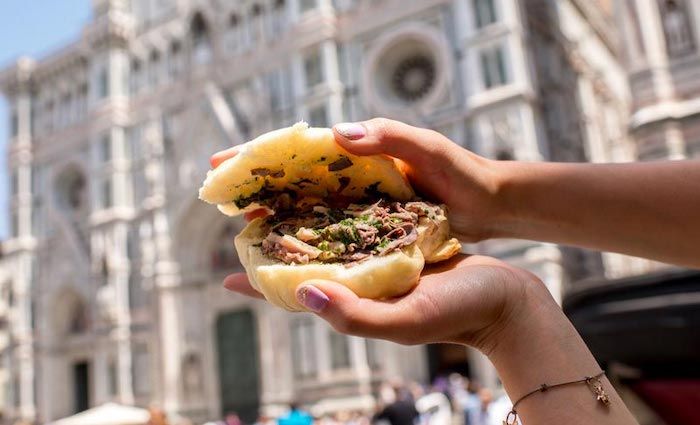
Cow Stomach | Primo | Florence
Do you consider yourself daring? If so, find a great lampredotto stand and have a sandwich prepared from the fourth stomach of a cow. The traditional lampredotto is likely the product of trying to get the most out of each animal to feed the general population in times where wealth and food were not in abundance.
Today, it’s a local favorite street food. Lampredotto is commonly served as a sandwich. Some say it’s delicious and others cringe at the sight of it. You’ll only know if you try it and the best place to do that is in Florence! Check out some other top foods to try in Florence and where to get them.
6. Carciofi alla Giudia and alla Romana
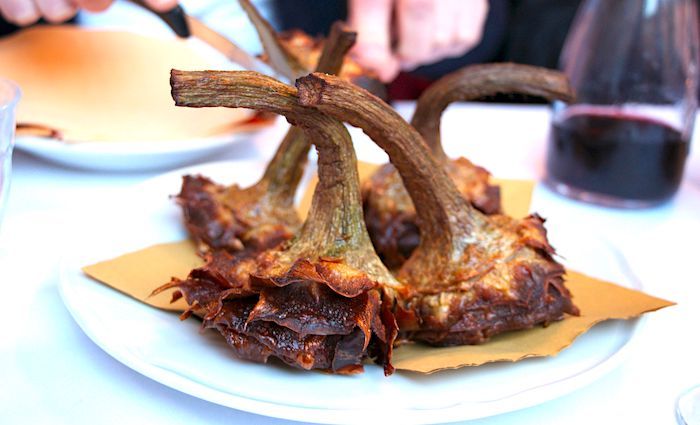
Artichoke | Antipasto | Rome
Carciofi or artichokes thrive in Rome’s climate, so they’re very popular in the city. There are two main ways of preparing artichokes: alla Giudia or “Jewish-style” (featured above) and alla Romana (Roman-style). Don’t worry, you’re free to prefer either style without fear of reprisal. However, Carciofi alla Giudia are almost always chosen as the victor.
Jewish-style artichokes are seasoned with salt and pepper and twice-fried in olive oil, which is how they get their super crispy texture. The secret is also in the high-quality olive oil, which has a different boiling point and is perfect for twice-frying.
Roman-style artichokes are completely different. The only thing that’s the same is the artichokes. The preparation and cooking time in carciofi alla Romana is more intensive. These artichokes are most often served cold but cooked for up to 30 minutes.They’re seasoned with lemon, mint, garlic, olive oil, and black pepper.
So, how do you know when to choose Carciofi alla Giudia or alla Romana? With the utmost respect, I would stick to religion on this one. If the restaurant is run by Catholics, I’d order Roman-style artichokes. If it’s Jewish-run or in the Jewish Ghetto, I would order the Jewish-style artichokes without question. Ideally, though, try both styles!
5. Saltimbocca alla Romana
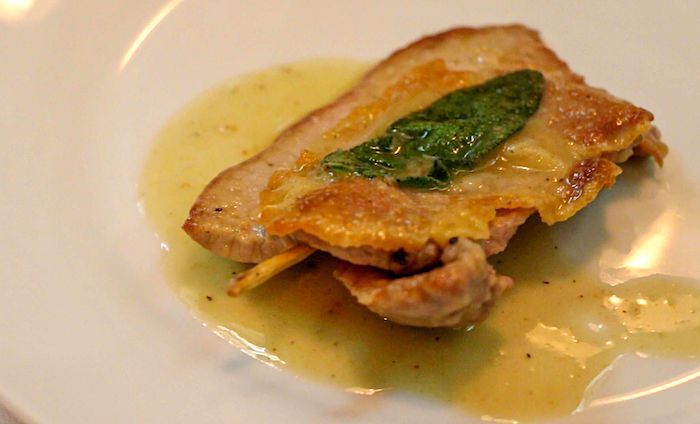
Veal | Secondo | Rome
This dish was invented sometime in the 19th century. As always, it’s simple with high quality ingredients. It’s a veal filet with a slice of sweet prosciutto crudo attached to it with a tooth-pick. It’s sautéed in butter with white wine and lightly salted with a bit of salvia to add flavor. It is a purists dish in Rome with little variation.
The name saltimbocca translates to “jumps in your mouth,” which accurately describes its incredible flavor. The photo above admittedly does not jump off the page but it’s one of those things you’ll understand when you try.
Many visitors to Italy will order a pasta dish as their meal but the right way to do things is to order antipasto (appetizer), primi (pasta), secondo (meat), and so on. Saltimbocca is a light secondo that you can finish on your own or share. Sharing in Italy is perfectly normal and expected.
4. Gnocchi con sugo di carne
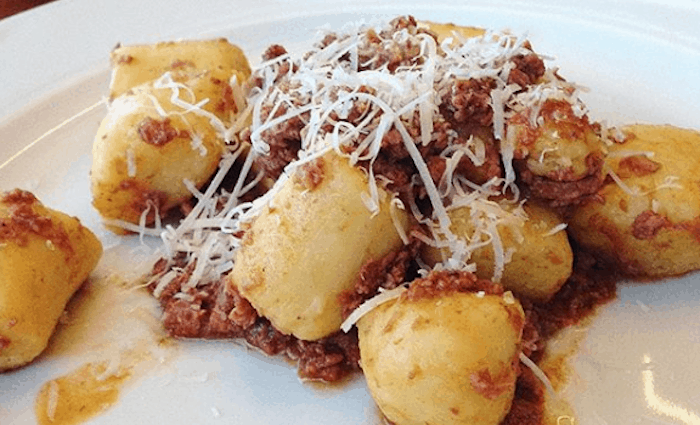
Potato Dumplings in Meat Sauce | Primo | Rome
One of the most wonderful things about Rome, and Italy as a whole, is the tradition. Imagine there were rules for everything you eat and drank but they were rules based on tradition and culture that everyone loved and adored. That is how Rome works and this applies to gnocchi, which are only served on Thursdays at traditional trattoria in Rome.
Gnocchi are prepared from potato and other heavy ingredients. A big plate of gnocchi with sugo di carne (tomato meat sauce) is more than filling. For this reason, Thursdays can be a pretty exciting day.
In Rome, meat was prohibited on Fridays as penance on the day of Christ’s death—not just during lent, but all year around. So, people ate fish on Fridays, which is delicious but is often a very light meal.
In preparation of Friday’s lighter meal, Romans figured they’d eat gnocchi on Thursdays to fill up. Then, they’d eat la trippa on Saturday to balance the scales since it’s also a heavier meal.
You can probably get a plate of gnocchi at a tavola calda or pizza place that serves daily dishes for €5 or so on a paper plate or in a to-go container. Boy are they delicious too. Regardless, if you want to be traditional in a good way, order gnocchi con Sugo di Carne while in Rome on a Thursday.
Not ready to book a tour? See if a Rome food tour is worth it.
3. Pizza
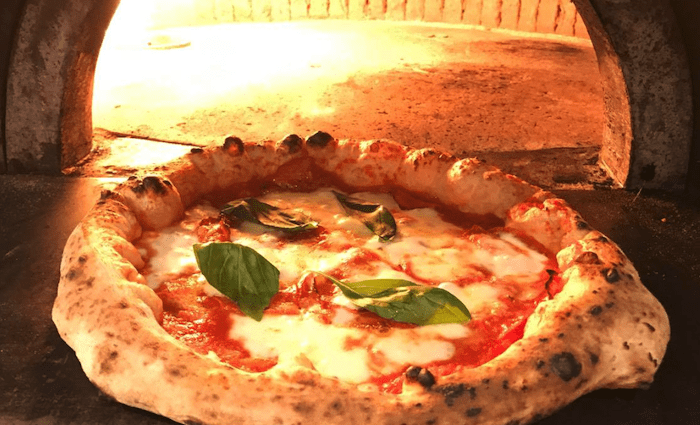
Pizza | Primo | All of Italy
I already know what you’re going to say: “I can eat pizza anywhere, why put it on this list?” The reason is simple and I will explain. While it is true that you can eat pizza anywhere in the world, pizza as we know it was invented in Naples. That’s reason enough to try one of the world’s favorite dishes in Italy.
However, there are two main styles of pizza: pizza Romana and pizza Napolitana. The main difference between these two styles is the crust. While there have been many variations over the centuries, the pizza we know and love today got its start in Naples in the 19th century.
The pizza Napolitana is very doughy and will have a huge crust that goes all the way around the pizza. While it is true that Naples has history on its side, the pizza Romana is paper-thin with practically no crust at all. Some people prefer one over the other, but if you have a chance, try them both. They’re both delicious!
2. Fritto Misto di Frutti di Mare
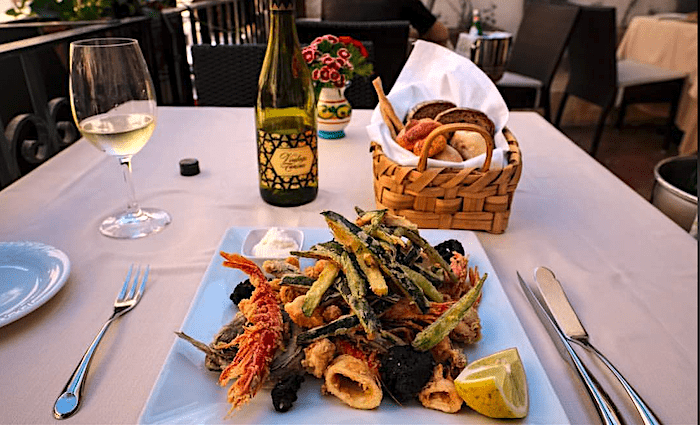
Deep Fried Shellfish | Secondo | On Italy’s Coast
The fritto misto translates to “mix fried,” so you can expect various kinds of lightly battered and deep-fried seafood. If you like fried food and you like seafood, this is a no-brainer. It isn’t a heavy batter and it’s not fried like KFC—it’s fried and battered just enough.
Depending on where you go on the coast, they’ll probably mix up the fish used. The usual suspects are calamari and shrimp, but they could throw in any number of delicious things according to the restaurant.
By the way, there’s no tartar sauce in Italy. Actually, there might be, but it is not used very often. For your fritto misto, they’ll give you a lemon, so squirt it on there and enjoy!
1. L’Amatriciana
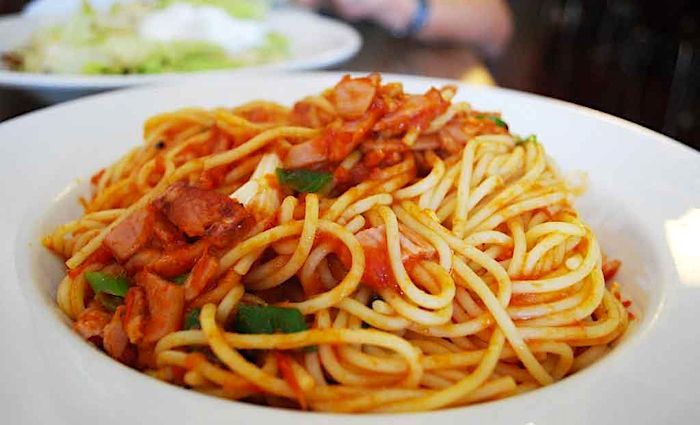
Pasta with Pork | Primo | Rome
Like any good rivalry, Rome is split between l’amatriciana and la carbonara. Both pasta dishes are delicious and it would be impossible to decide which one is actually better. I can’t take sides but I do tend to make l’amatriciana more often, so it’s my number one favorite dish in Rome.
Like many of the best Italian dishes, this Roman favorite is made with simple ingredients. It’s often made at home with la passata, which is a quick tomato sauce base but you couldn’t do that in a restaurant without Italians noticing.
You should use cherry tomatoes (pomodori ciliegini), fresh chilli peppers (peperoncino), pork cheek (gaunciale), and, most importantly, pecorino cheese (pecorino romano). For the pasta, you should use spaghetti or bucatini (spaghetti in the form of a straw). This is yet another rivalry between Amatriciana purists: spaghetti or bucatini?
Bucatini is arguably the original recipe, which I also prefer. But in Rome, this dish could be served with spaghetti or even maniche corte, which are about half as long as rigatoni and used more commonly in Rome. No matter the pasta, order L’Amatriciana in Rome—it’s an absolute must!
Food Tours and Cooking Experiences in Italy
We all dream of eating in Italy because there’s no cuisine quite like Italian cuisine, right? Now, you know what foods and drinks to try and where to get them!
But if you’re looking to have a real foodie experience paired with a fantastic evening out exploring a new city, meeting the locals, or learning to cook classic Italian dishes yourself, check out our food tours and cooking experiences in Florence, our food tours, cocktail evenings, and cooking classes in Rome, and our local food and drink tours in Venice.

